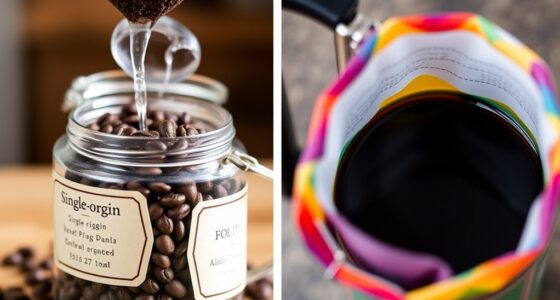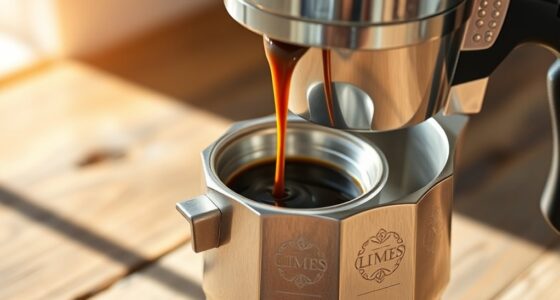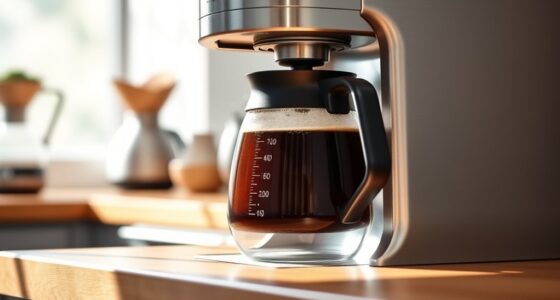To pull a perfect espresso at home, start with high-quality, freshly roasted beans and grind them just before brewing to preserve flavor. Maintain your machine with regular cleaning, descaling, and checking seals. Ensure stable temperature around 200°F and pressure near 9 bars for ideal extraction. Measure your coffee dose accurately, tamp evenly, and pull shots for 25-30 seconds. Paying attention to these details will help you craft café-quality espresso—continue to learn more tips to improve your technique.
Key Takeaways
- Use freshly roasted, high-quality beans and grind just before brewing for maximum freshness.
- Maintain your espresso machine by regular cleaning and descaling to ensure consistent performance.
- Keep water temperature between 195-205°F and pressure around 9 bars during extraction.
- Measure coffee precisely, tamp evenly, and aim for a 25-30 second shot for optimal flavor.
- Develop a consistent routine for dosing, tamping, and timing to achieve café-quality results at home.

Ever wondered how to enjoy a rich, flavorful espresso without leaving your house? The secret starts with the right coffee bean selection. Choosing high-quality, freshly roasted beans is essential because they directly impact the flavor and aroma of your shot. Opt for beans specifically labeled for espresso, which tend to be darker roasted to bring out those bold, intense flavors. Grinding your beans just before brewing ensures maximum freshness and helps preserve the complex oils that contribute to a well-rounded shot. Remember, the grind size is crucial—too fine, and the water will struggle to pass through; too coarse, and your espresso will be weak and underwhelming.
Choosing fresh, high-quality beans and grinding just before brewing maximizes flavor and aroma for a perfect espresso.
Once you’ve picked the perfect beans, maintaining your espresso machine becomes just as important. Regular espresso machine maintenance isn’t just about keeping it looking good; it’s about guaranteeing each shot tastes as fresh and vibrant as possible. Clean the portafilter, basket, and steam wand after every use to prevent the buildup of coffee oils and mineral deposits that can turn your espresso bitter. Descaling your machine periodically, following the manufacturer’s instructions, helps prevent clogs and keeps water flow consistent, which is vital for achieving that perfect extraction. Additionally, regular maintenance can extend the lifespan of your machine and ensure optimal performance over time. Also, check the seals and gaskets for wear and replace them if necessary—this helps maintain pressure and temperature stability during brewing.
Getting the most out of your espresso machine also involves paying attention to temperature and pressure. A stable temperature (around 195-205°F) is key for extracting optimal flavors, so don’t neglect your machine’s thermostat. Preheat your machine thoroughly before pulling a shot, so the water hits the coffee at the right temperature. Proper pressure (around 9 bars) ensures proper extraction and crema formation. If your machine allows, adjust these settings for a customized experience, but if not, just ensure your device is well-maintained and functioning correctly.
Furthermore, mastering espresso is about consistency. Stick to a routine—measure your coffee dose accurately, tamp with even pressure, and time your shot precisely, typically around 25-30 seconds. Practice makes perfect, and over time, you’ll develop a feel for what works best with your machine and beans. Using a quality tamping technique can significantly improve shot consistency and flavor extraction. Remember, every element—from selecting fresh beans and grinding correctly to maintaining your equipment—plays a vital role in pulling that perfect shot. With a little effort and attention to detail, you’ll be savoring espresso at home that rivals your favorite café, all from the comfort of your own kitchen.
Frequently Asked Questions
How Do I Clean My Espresso Machine Properly?
To keep your espresso machine in top shape, you need proper machine maintenance and regular cleaning. Start by rinsing the portafilter and filter basket after each use. Run water through the machine using cleaning solutions designed for espresso machines weekly, and descale it as recommended. Be sure to clean the drip tray and steam wand thoroughly. Regular maintenance prevents buildup and guarantees your machine produces great-tasting espresso every time.
What Grind Size Is Best for Espresso?
Did you know that 60% of espresso enthusiasts say grind size hugely impacts flavor? For the best shot, you want a fine, consistent grind. A burr grinder performs better than blade grinders, offering superior grind consistency that’s essential for extracting the perfect espresso. Adjust the grind size until you find that ideal fine texture—this ensures ideal extraction and a rich, flavorful shot every time.
How Can I Tell if My Espresso Shot Is Good?
You can tell if your espresso shot is good by observing the espresso timing and crema quality. A well-pulled shot should take about 25-30 seconds, ensuring proper extraction. Look for a rich, golden crema that’s thick and persistent—this indicates good flavor and freshness. If the shot pulls too quickly or slowly, or the crema is pale or thin, adjust your grind size or tamping.
What’s the Ideal Water Temperature for Brewing?
Your brewing precision is critical, and the water temperature is like the maestro conducting a symphony. Aim for about 195-205°F (90-96°C) for the perfect shot. Too hot, and you’ll scorch the coffee; too cold, and you’ll miss out on flavor. Maintaining this ideal range ensures a rich, balanced espresso every time, delivering a shot that’s as vibrant and enthralling as a masterpiece.
How Often Should I Descale My Espresso Machine?
You should descale your espresso machine every 1-3 months, depending on usage and water hardness. Regular descaling is essential for machine maintenance, preventing mineral buildup that can affect performance and coffee flavor. If you notice slower water flow or a change in taste, it’s time to descale. Following the recommended descaling frequency ensures your machine stays in top shape, producing consistent, high-quality espresso shot after shot.
Conclusion
Now that you’ve learned how to pull the perfect shot, it’s almost like your coffee mug was waiting for this moment all along. Maybe you’ll find yourself enjoying that rich aroma just as much as the first sip, feeling a little more like a barista in your own kitchen. Sometimes, it’s those small, unexpected successes—like nailing your espresso—that remind us how satisfying the simple things can be. Cheers to many perfect pulls ahead!









